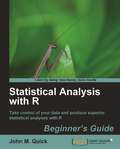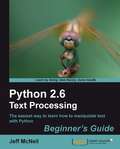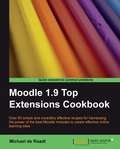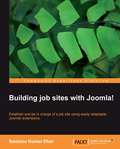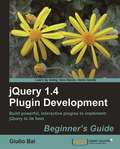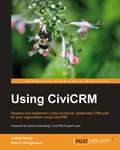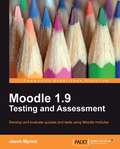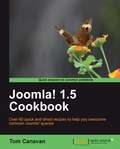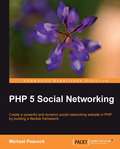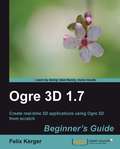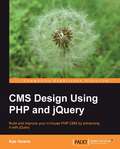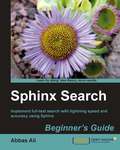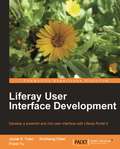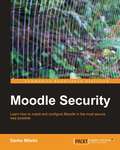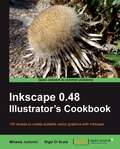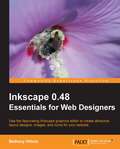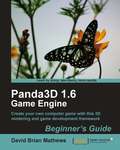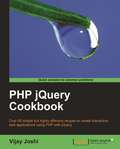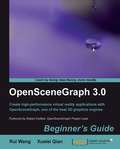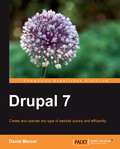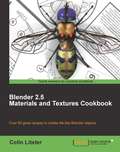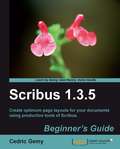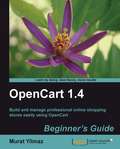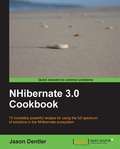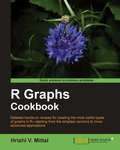- Table View
- List View
Statistical Analysis with R
by John M. QuickThis is a practical, step by step guide that will help you to quickly become proficient in the data analysis using R. The book is packed with clear examples, screenshots, and code to carry on your data analysis without any hurdle.If you are a data analyst, business or information technology professional, student, educator, researcher, or anyone else who wants to learn to analyze the data effectively then this book is for you.No prior experience with R is necessary. Knowledge of other programming languages, software packages, or statistics may be helpful, but is not required.
Python 2.6 Text Processing: Beginners Guide
by Jeff McneilThis book is part of the Beginner's Guide series. Each chapter covers the steps for various tasks to process data followed by brief explanation of what is happening in each task. The explanation is followed by a few questions on the topic under discussion that will serve as a refresher course for you. This book is for people who have text in one format, and need it in another, as quickly as possible. You don't need any experience with text processing, but you will need some basic knowledge of Python.
Moodle 1.9 Top Extensions Cookbook
by Michael De RaadtThe disorganised array of modules available for Moodle are brought together in ways you can relate to. Reviews include details that will help you decide if a module is worth testing. There are illustrated, step-by-step guides to installing and configuring modules.If you are involved in teaching using Moodle, be it at relatively small institutions running their own Moodle instance, or at large institutions where Moodle is used and administered, or you are an administrator of a Moodle instance who is looking for modules that will be useful to teachers and students at their institution, this book is meant for you.Get students organised and help them manage their time
Building job sites with Joomla!
by Santonu Kumar DharThis will be a step-by-step tutorial - a workbook with practical approach. The book starts by looking at the important features that make a professional job site: adding and managing jobs, jobseekers and employers, providing online recruitment services, selling credits and managing credit system, SEO to drive huge traffic to your job site, and so on. This book includes a lot of screenshots which not only illustrate tasks but also create a visual impact. This book contains overall necessary information that is important for the understanding of job site development. If you are looking for building and managing a job site using Joomla! extensions then this book is for you. Prior knowledge of using extensions is not expected but Joomla! basics will be required.
jQuery Plugin Development Beginner's Guide
by Giulio BaiThis book takes a beginner's guide approach, giving you step-by-step instructions for creating a number of different jQuery plugins covering most of the common issues one may encounter when working on web pages and sites. It is a practical guide, which will show you how to design and build the most commonly used jQuery plugins.This book is for anyone who wants to have a better understanding of the dynamics of jQuery when plugins come into play, as well as for those who are willing to push jQuery to its limits and develop awesome plugins to use in their websites. A little background information about JS and jQuery cannot harm, but even very beginners can have a chance to be introduced to the wonderful world of jQuery.
Using CiviCRM
by Brian Shaughnessy Joseph MurrayThis book is a step-by-step tutorial with practical examples, introduced by a planning framework and illustrations of good relationship management techniques for a variety of situations. We begin with basics such as installation, low-level implementation, and CiviCRM's core modules before covering CiviCRM's advanced features and issues such as customization of CiviCRM and integrating it with Joomla! and Drupal. You should be able to quickly grasp and implement the basic elements of CiviCRM before moving on to the more advanced features and tools. This book is for project implementers, organization leaders, staff, and volunteers in advocacy, non-profit, and non-governmental organizations, elected officials, professional/trade associations, political campaigns and parties, government agencies, and other similar organizations who want to implement CiviCRM in a manner tailored to their organization's size, culture, and needs. It addresses CRM strategists, implementers, administrators, and end users looking to become power users in communicating, fundraising, managing events, memberships, grants, cases, and people-resource management.
Moodle 1.9 Testing and Assessment
by Jason MyrickThis book is an illustrative how-to guide with many screenshots and examples that helps you to create simple to complex tests and assess them using Moodle. It covers effective usage of tools available in Moodle and offers some Moodle options that you may not have tried yet. It will guide you from the basic philosophy of online testing to creating skill-based assessments in Moodle.If you are a tutor or Moodle Administrator who is responsible for developing and evaluating an online test using Moodle, then this book is for you.This book assumes that you have already successfully installed and set up a Moodle site for teaching.
Joomla! 1.5 Cookbook
by Tom CanavanThis is a fast paced cookbook, with practical recipes providing tips and tricks to the most common problems and scenarios faced by Joomla! site owners. It also covers brand new concepts and scenarios of Joomla! 1.6.If you are a Joomla! site owner and have some problems that you want to get rid of quickly; or you just want to get particular things working or improved, this is the book for you. HTML, CSS, or programming knowledge not required.
PHP 5 Social Networking
by Michael PeacockThis book is a fast-paced tutorial focusing on creating a Social Networking framework through an ongoing case study. It presents a lot of real-world code, with comprehensive explanation and discussion. With each chapter, the Social Networking framework is extended, with more functionality being added as we progress through the book.This book is primarily aimed at PHP developers, but is suitable for any web developers looking to expand their knowledge and understanding of Social Networking concepts. Intermediate knowledge of PHP and object-oriented programming is assumed, along with a basic knowledge of MySQL.
OGRE 3D 1.7 Beginner's Guide
by Felix KergerThis book is an example-driven introduction to OGRE 3D. Each example shows some new features and you learn step-by-step to create complex scenes with different effects using OGRE 3D. After several examples discussing one topic there is a do-it-yourself part where you will be challenged to solve problems on your own.If you have ever wanted to develop 3D applications with OGRE 3D, this example-driven book will enable you to do so. Understanding of C++ is needed to follow the examples in the book.
CMS Design Using PHP and jQuery
by Kae VerensThis is a practical, tutorial-style book that develops a project from start to finish, explaining all aspects of the project. Every chapter starts by explaining what is to be accomplished and the various ways in which the problem may be tackled, followed by an in-depth explanation of the chosen solution. If you want to see jQuery in action with PHP and MySQL code, in the context of a real application, this is the book for you. It is written for developers who have written multiple scripts or websites, and want to know how to combine them all into one package that can be used to simplify future scripts and sites. The book is aimed at people who understand the basics of PHP and jQuery, and want to know how they can be used effectively to create a large project that is user-friendly and flexible.
Sphinx Search Beginner's Guide
by Abbas AliThis book is a step-by-step guide for an absolute beginner. It covers everything, from installing to configuring, to get you started quickly. It has numerous code examples that the reader can try on their own and learn while doing so. It has two full-fledged applications as examples that readers can follow. This book is specifically focused on the Search feature of web applications.This book is for developers who are new to Sphinx Search. All code examples use PHP but the logic is same for any other web scripting languages as well.
Liferay User Interface Development
by Xinsheng Chen Jonas X. YuanThis is a basic tutorial that teaches you how to use the tools provided by Liferay to create your own applications. It covers a lot of the material that has API references and documentation of the architecture and illustrates its key concepts with examples.If you have basic knowledge of Java Web applications, know the basic operational functionality of Liferay, and have written a servlet or JSP file, you are ready to get the most out of this book. Whether you are a web portal engineer or an experienced Liferay Portal developer, you can benefit from this book. You are not expected to have prior knowledge of Liferay theming.
Moodle Security
by Darko MiletiMoodle Security is packed with practical examples, which guide you through optimizing the protection of your Moodle site. Each chapter covers a different security threat and how to secure your site against it. You will also find recommendations for what is best for your particular system and usage. If you are in charge of Moodle - whether you are an administrator or lead teacher - then securing it is one of the most important things that you can do. You need to know the basics of working with Moodle, but no previous experience of system administration is required.
Inkscape 0.48 Illustrator's Cookbook
by Rigel Di Scala Mihaela JurkoviEach recipe comprises step-by-step instructions followed by an analysis of what was done in each task and other useful information. The book is designed so that you can read it chapter by chapter, or look at the list of recipes and refer to them in no particular order. It is packed with useful screenshots to make your learning even easier.This book is written for both beginners and developers who have a basic knowledge of Inkscape. With this book illustrators who have just started using Inkscape can quickly dive into the world of Inkscape and graphics editing. Software developers and web designers can learn how to create graphics for their software on their own or build SVG and other web-based interfaces. Users of other graphics editing applications can find out how Inkscape can be used as an alternative to solve common graphics problems.
Inkscape 0.48 Essentials for Web Designers
by Bethany HiitolaThis book is written in a clear conversational style, which emphasizes a practical learn-by-doing approach. Packed with illustrations and examples, this book will make the task of using Inkscape simple and straightforward.This book is written for web designers who want to add attractive visual elements to their website. It assumes no previous knowledge of Inkscape. General familiarity with vector graphics programming is recommended but not required. It will also be a useful guide for experienced Inkscape users who want to learn how to apply their skills to website design.
Panda3D 1.6 Game Engine Beginner's Guide
by David Brian MathewsThis book is a step-by-step, tutorial-driven guide to game or application development using Panda3D that follows the process used in professional development. You will learn through first-hand experience how a Panda3D developer goes from literally nothing to a finished product. Along the way there are illustrations to explain difficult topics and to display the results of progress, as well as a complete archive of thoroughly explained code for every tutorial. Every single code file the reader saves is mirrored in the example code, finished and explained. In addition, every art and audio asset required by the tutorials is provided, so the user need not provide any assets of their own. If you are an independent developer interested in creating your own video games or other 3D applications using Panda3D for personal or commercial distribution at minimal expense, this book is definitely for you. A basic understanding of general programming, such as familiarity with the concept of a variable, is necessary. Some familiarity with object-oriented programming and the Python language is expected, but not essential. This book does not cover the creation of three dimensional models or similar art assets, nor does it cover the creation of two dimensional art assets or audio assets.
PHP jQuery Cookbook
by Vijay JoshiWritten in Packt's cookbook style, this book presents numerous practical examples that you can use directly in your applications. The book covers most of the essential issues you will face while developing your web applications and gives solutions to them. Recipes in the book are written in a manner that will rapidly take you from a beginner to expert level.If you want to use PHP and jQuery together to create web applications this book is for you. It provides a large number of examples in each chapter that will take you from a basic developer to a pro by giving step-by-step instructions for each task in developing web applications using PHP and jQUery. All you need are JavaScript basics and you are on your way to building power web applications, with this book in hand.
OpenSceneGraph 3.0: Beginner's Guide
by Xuelei Qian Rui WangWritten with a fast-paced but friendly and engaging approach, this Packt Beginner's Guide is designed to be placed alongside the computer as your guide and mentor. Step-by-step tutorials are bolstered by explanations of the reasoning behind what you are doing. You will quickly pick up the necessary skills, tips, and tricks for creating successful 3D graphics with practical examples that help you to learn by experiment and play.This book is intended for software developers who are new to OpenSceneGraph and considering using it in their applications. It is assumed that you have basic knowledge of C++ before using this book, especially the standard template library (STL) constructs, of which OSG makes extensive use. Some familiarity with design patterns as implemented in C++ is also useful, but is not required.You need to be familiar with OpenGL, the standard cross-platform low-level 3D graphics API. We'll meet some maths in the book--geometry and linear algebra--and familiarity with these topics will be great, but you don't need to be a maths whiz to use this book.
Drupal 7
by David MercerThe approach of this book has been revised and updated for Drupal 7 based on comments from thousands of readers. The book takes a pragmatic look at the steps necessary to get a website up and running. Drawing on years of writing experience, David Mercer utilizes a friendly, engaging style that is both clear and concise--perfect for the Drupal newbie. This book is for people with little or no experience in website design, people who are not necessarily familiar with PHP, MySQL or HTML, and above all people with little to no experience in using Drupal. familiar with PHP, MySQL or HTML, and above all people with little to no experience in using Drupal.
Blender 2.5 Materials and Textures Cookbook
by Colin LitsterEach chapter in the book follows a themed approach to creating materials using the new Blender 2.5 features. As you read through each chapter you will learn approaches to create materials and textures. These materials and textures will help you to create a flawless simulation of real-world objects. You need not read the chapters in any particular order to learn to use the Blender 3D suite for materials simulation appropriately. Every recipe in this book will enable you to create a usable material or texture effect as well as teaching you techniques that save your time. If you are a Graphics Designer looking to master the features for materials and textures to create realistic looking models in Blender, then this book is for you. It can be read by both beginners and experienced Blender users; however, prior understanding of object creation and manipulation in Blender would be an advantage. This is a must-read for Blender users who want to learn the concepts and at the same time experiment with the different Blender Material and texture functions.
Scribus 1.3.5: Beginner's Guide
by Cedric GemyThis book is a step by step guide packed with interesting examples and screenshots that cover lot of support options to help you achieve the superior quality documents. This books is divided into 11 chapters, each chapter dealing with a precise aspect of the software to help you have the best overview and make the best design choices for your document. This book is for people who want to create professional-looking documents with Scribus. If you want a great looking brochure, newsletter, or poster, this is the book for you. No experience of desktop publishing software is required - only creativity and enthusiasm for creating great documents!
OpenCart 1.4: Beginner's Guide
by Murat YilmazThis is a tutorial-style book that follows a practical approach to demonstrate the potential of OpenCart. The book is suitable for those who have basic computer skills. Written with a fast-paced but friendly and engaging approach, this Packt Beginner's Guide is designed to be placed alongside the computer as your guide and mentor. Step-by-step tutorials are complemented with explanations of the reasoning behind what you are doing. You will quickly pick up the necessary skills, tips and tricks for building a successful OpenCart online store with practical examples that helps you to learn by experiment and play. This book is aimed at individuals who want to develop professional online stores without any hands-on programming experience, and clients/non-developers who will be managing their inventory and processing orders through the backend.
NHibernate 3.0 Cookbook
by Jason DentlerThis book contains quick-paced self-explanatory recipes organized in progressive skill levels and functional areas. Each recipe contains step-by-step instructions about everything necessary to execute a particular task. The book is designed so that you can read it from start to end or just open up any chapter and start following the recipes. In short this book is meant to be the ultimate "how-to" reference for NHibernate 3.0, covering every major feature of NHibernate for all experience levels.This book is written for NHibernate users at all levels of experience. Examples are written in C# and XML. Some basic knowledge of SQL is assumed.
R Graph Cookbook
by Hrishi V. MittalThis hands-on guide cuts short the preamble and gets straight to the point - actually creating graphs, instead of just theoretical learning. Each recipe is specifically tailored to fulfill your appetite for visually representing you data in the best way possible. This book is for readers already familiar with the basics of R who want to learn the best techniques and code to create graphics in R in the best way possible. It will also serve as an invaluable reference book for expert R users.
